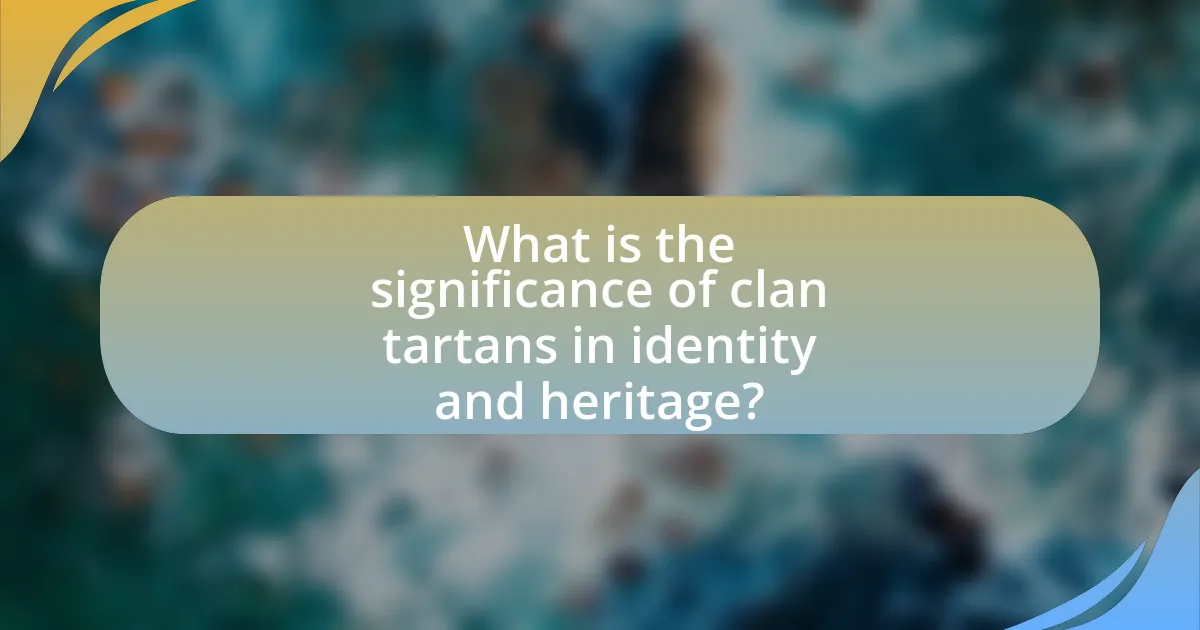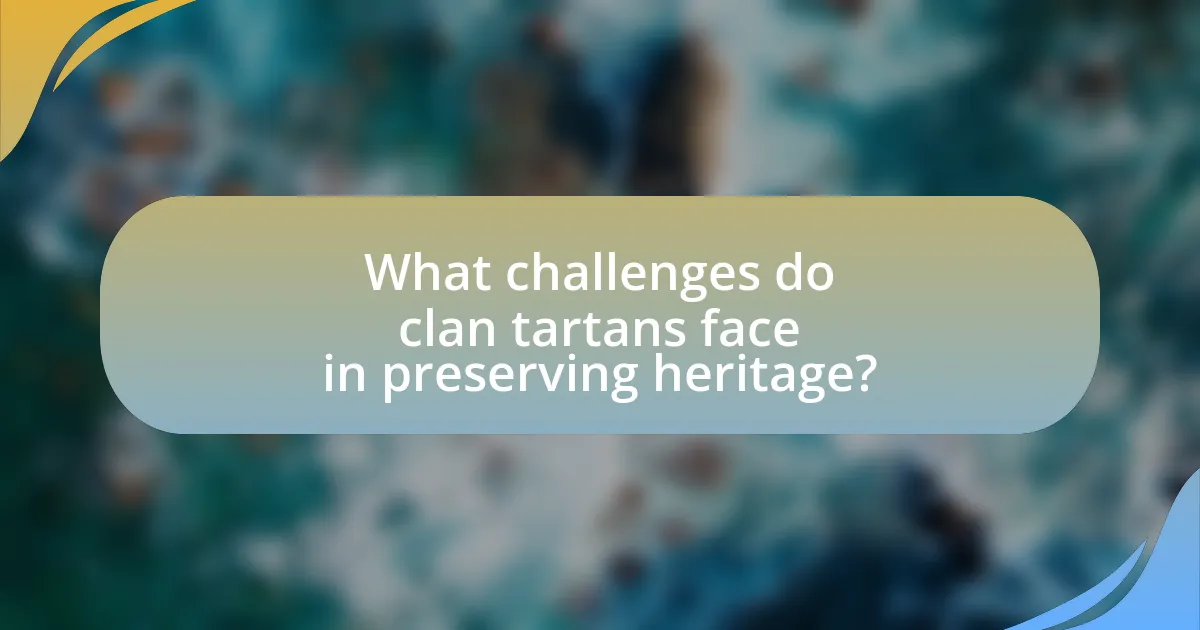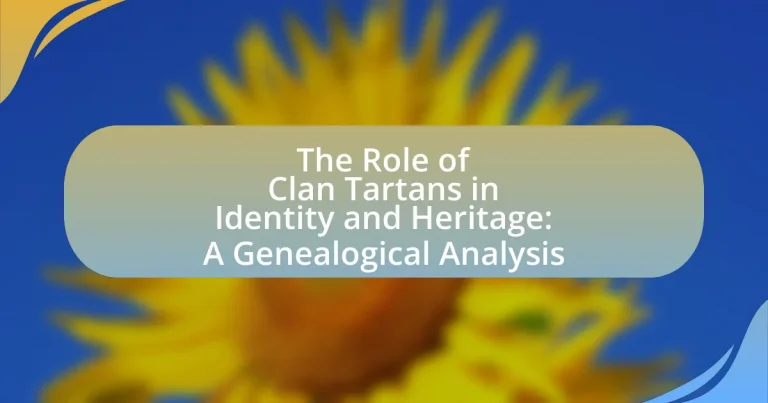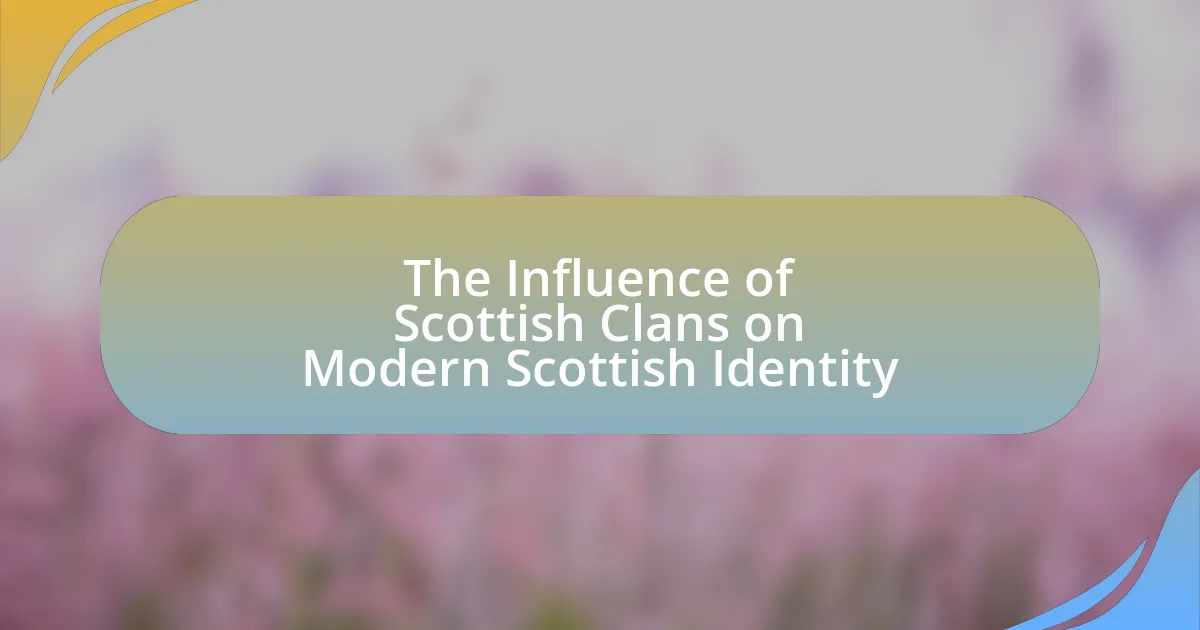Clan tartans are integral to Scottish identity and heritage, serving as visual symbols that represent specific clans and foster a sense of belonging among their members. Each tartan pattern is unique, reflecting historical events, geographical origins, and familial ties, which reinforces collective identity. The article explores the significance of clan tartans in cultural identity, their historical development influenced by events like the Jacobite uprisings, and their role in genealogical research. It also examines how tartans reflect regional differences, contribute to community cohesion, and face challenges in preserving authenticity amid commercialization. Additionally, the article discusses contemporary adaptations of tartans in fashion and design, emphasizing their ongoing relevance in celebrating Scottish heritage.

What is the significance of clan tartans in identity and heritage?
Clan tartans are significant in identity and heritage as they serve as visual symbols representing specific clans, fostering a sense of belonging and cultural pride among members. Each tartan pattern is unique to a clan, often linked to historical events, geographical origins, and familial ties, which reinforces the collective identity of its members. For instance, the MacLeod tartan is associated with the MacLeod clan of Lewis and Skye, reflecting their distinct lineage and history. This connection to heritage is further emphasized during cultural events, such as Highland games and clan gatherings, where tartans are worn to signify unity and shared ancestry. Thus, clan tartans play a crucial role in preserving and expressing cultural identity within Scottish heritage.
How do clan tartans represent cultural identity?
Clan tartans represent cultural identity by serving as distinctive symbols that signify lineage, heritage, and community belonging. Each tartan pattern is associated with a specific clan, reflecting its history, values, and geographical roots. For example, the MacLeod tartan features a unique color scheme and design that connects members to their ancestral lineage and traditions. Historically, tartans were used to identify clans during conflicts and gatherings, reinforcing social cohesion and a sense of pride among clan members. This connection to ancestry and shared identity is further emphasized in modern times, where wearing a clan tartan fosters a sense of unity and belonging within the community.
What historical events influenced the development of clan tartans?
The development of clan tartans was significantly influenced by historical events such as the Jacobite uprisings in the 17th and 18th centuries. These uprisings, particularly the 1745 rebellion led by Charles Edward Stuart, prompted a resurgence in Scottish nationalism and the use of tartans as symbols of clan identity. Following the defeat at Culloden, the British government imposed the Dress Act of 1746, which banned the wearing of tartan and kilts, further solidifying tartan as a symbol of resistance and cultural identity among Scots. The subsequent repeal of the Dress Act in 1782 allowed for the revival and popularization of tartans, leading to their association with specific clans and the establishment of distinct patterns that represented clan heritage.
How do clan tartans reflect regional differences within Scotland?
Clan tartans reflect regional differences within Scotland by showcasing distinct patterns and colors associated with specific clans and their geographic origins. Each tartan is often linked to a particular area, with variations in design that can indicate the clan’s historical territory, local resources, and cultural influences. For example, the MacLeod tartan features colors that are reminiscent of the landscapes of the Isle of Skye, while the Campbell tartan incorporates hues that reflect the natural environment of Argyll. This connection between tartan designs and regional characteristics illustrates how clan identity is intertwined with local heritage and geography, reinforcing the significance of tartans as symbols of both familial and regional pride.
Why are clan tartans important for genealogical research?
Clan tartans are important for genealogical research because they serve as a visual representation of familial and clan identity, linking individuals to their ancestral heritage. Each tartan pattern is associated with specific Scottish clans, which can help researchers trace lineage and familial connections. Historical records indicate that tartans were often worn by members of particular clans, making them a valuable tool for identifying and confirming genealogical ties. For example, the MacGregor tartan is directly linked to the MacGregor clan, allowing descendants to establish their heritage and connection to that lineage through the tartan’s distinct pattern.
How can clan tartans assist in tracing family lineage?
Clan tartans can assist in tracing family lineage by serving as identifiable symbols linked to specific Scottish clans, which often have documented histories and genealogies. Each tartan pattern is associated with a particular clan, allowing individuals to connect their ancestry to that clan’s historical records. For example, the MacGregor tartan is tied to the MacGregor clan, which has extensive genealogical documentation that can help individuals trace their lineage back through generations. This connection between tartans and clan heritage provides a tangible link to family history, enabling researchers and descendants to explore their roots more effectively.
What role do clan tartans play in connecting individuals to their ancestry?
Clan tartans serve as a visual representation of heritage, connecting individuals to their ancestry through distinct patterns associated with specific clans. Each tartan pattern is linked to a particular Scottish clan, symbolizing familial ties and cultural identity. Historically, these patterns were used to identify members of clans, especially during battles or gatherings, reinforcing a sense of belonging and community. The use of tartans in modern contexts, such as family reunions or cultural events, continues to evoke pride in one’s lineage and fosters connections among individuals sharing the same ancestral roots.

How do clan tartans contribute to community and social cohesion?
Clan tartans contribute to community and social cohesion by serving as symbols of shared identity and heritage among members of a clan. These distinctive patterns foster a sense of belonging and unity, as individuals wearing the same tartan can easily identify each other as part of a larger community. Historical evidence shows that clan tartans have been used since the 16th century in Scotland, where they represented specific clans and their unique histories, thus reinforcing social bonds. Additionally, events such as Highland games and clan gatherings often feature tartans prominently, further solidifying communal ties and collective identity among participants.
In what ways do clan tartans foster a sense of belonging?
Clan tartans foster a sense of belonging by symbolizing shared heritage and identity among members of a clan. These distinctive patterns are often associated with specific Scottish clans, creating a visual representation of familial ties and cultural history. The use of tartans during clan gatherings, ceremonies, and celebrations reinforces communal bonds, as individuals don the same patterns, signaling unity and collective identity. Historically, clan tartans have served as identifiers in battles and social events, further solidifying their role in fostering belonging. The emotional connection to a clan’s tartan can evoke pride and a sense of responsibility towards preserving cultural traditions, enhancing the feeling of belonging within the community.
How do clan gatherings and events utilize tartans to strengthen community ties?
Clan gatherings and events utilize tartans to strengthen community ties by fostering a shared identity and heritage among members. Tartans serve as visual symbols of clan affiliation, allowing individuals to express their belonging and pride in their lineage. The display of specific tartan patterns during gatherings reinforces connections among participants, as these patterns often represent historical narratives and familial bonds. For instance, the wearing of a clan tartan can evoke a sense of unity and collective memory, enhancing social cohesion within the community. This practice is rooted in the historical significance of tartans, which have been used for centuries to signify clan loyalty and identity, thus solidifying interpersonal relationships and communal bonds during events.
What impact do clan tartans have on inter-clan relationships?
Clan tartans significantly influence inter-clan relationships by fostering a sense of identity and solidarity among members of the same clan while simultaneously delineating boundaries with other clans. The distinct patterns and colors of tartans serve as visual symbols of heritage, promoting pride and unity within a clan, which can enhance internal cohesion. For example, during clan gatherings or events, the display of tartans reinforces a collective identity, encouraging members to strengthen their ties with one another. Conversely, the unique characteristics of each clan’s tartan can also create a sense of rivalry or distinction between clans, as seen historically in clan conflicts in Scotland, where tartans were emblematic of allegiance and territorial claims. This dual role of clan tartans—both as a unifying force within clans and as markers of distinction between them—illustrates their complex impact on inter-clan relationships.
How are clan tartans used in modern cultural expressions?
Clan tartans are used in modern cultural expressions primarily as symbols of Scottish heritage and identity. These distinctive patterns represent specific clans, allowing individuals to connect with their ancestral roots and showcase their lineage. For instance, tartans are prominently featured in traditional Scottish attire, such as kilts and sashes, worn during cultural events, weddings, and festivals, reinforcing a sense of belonging and pride among clan members. Additionally, contemporary fashion designers incorporate tartan patterns into modern clothing and accessories, further popularizing their use beyond traditional contexts. This integration into various cultural expressions highlights the ongoing relevance of clan tartans in celebrating and preserving Scottish identity.
What are the contemporary adaptations of traditional tartans?
Contemporary adaptations of traditional tartans include modern fabric blends, innovative color palettes, and diverse applications in fashion and home decor. Designers are reinterpreting classic tartan patterns by incorporating contemporary aesthetics, such as minimalist designs and bold color combinations, which appeal to a broader audience. Additionally, tartans are now used in various products beyond clothing, including accessories, upholstery, and even tech gadgets, reflecting a shift in cultural relevance and accessibility. This evolution demonstrates how traditional tartans are being integrated into modern lifestyles while maintaining their historical significance.
How do fashion and design incorporate clan tartans today?
Fashion and design incorporate clan tartans today by using them as symbols of cultural identity and heritage in various clothing and accessory lines. Designers often integrate traditional tartan patterns into contemporary garments, such as skirts, jackets, and scarves, to evoke a sense of belonging and connection to Scottish ancestry. For instance, brands like Burberry and Vivienne Westwood have famously utilized tartan in their collections, blending historical significance with modern aesthetics. This practice not only celebrates the rich history of clan tartans but also appeals to consumers seeking authenticity and personal connection in their fashion choices.

What challenges do clan tartans face in preserving heritage?
Clan tartans face significant challenges in preserving heritage due to commercialization, dilution of traditional patterns, and lack of awareness among younger generations. Commercialization has led to mass production of tartans that often do not adhere to historical accuracy, undermining their cultural significance. Additionally, the introduction of new designs can dilute the authenticity of traditional clan patterns, making it difficult to maintain a clear connection to heritage. Furthermore, as younger generations become less engaged with their clan’s history, the transmission of knowledge about tartans and their meanings diminishes, threatening the continuity of this cultural practice.
How is the authenticity of clan tartans maintained?
The authenticity of clan tartans is maintained through strict adherence to historical patterns and colors that are documented and recognized by clan societies. These societies often have registries that preserve the original designs and specifications of tartans, ensuring that any reproduction aligns with the established standards. For instance, the Scottish Register of Tartans, established in 2008, serves as an official record that validates the authenticity of tartans by requiring detailed descriptions and historical context for each entry. This system helps prevent unauthorized variations and promotes the integrity of clan identities associated with specific tartans.
What issues arise from the commercialization of tartans?
The commercialization of tartans leads to issues such as cultural appropriation, loss of authenticity, and dilution of heritage. Cultural appropriation occurs when non-Scottish entities exploit tartan designs without understanding their significance, undermining the cultural identity they represent. The loss of authenticity arises when mass-produced tartans prioritize profit over traditional craftsmanship, resulting in inferior quality and a departure from historical patterns. Additionally, the dilution of heritage happens as the commercialization process often overlooks the unique stories and meanings associated with specific tartans, reducing them to mere fashion statements rather than symbols of clan identity and history.
How do organizations work to protect traditional tartan patterns?
Organizations protect traditional tartan patterns through registration, advocacy, and education. The Scottish Register of Tartans, for example, maintains an official database that records and protects the intellectual property of tartan designs, ensuring that they are not misused or commercially exploited without permission. Additionally, organizations like the Scottish Tartans Authority promote awareness of tartan heritage and provide resources for clans and individuals to understand their rights regarding tartan patterns. These efforts are crucial in preserving the cultural significance and authenticity of tartans, which are integral to Scottish identity and heritage.
What practical steps can individuals take to honor their clan tartan heritage?
Individuals can honor their clan tartan heritage by wearing clothing made from their specific tartan, which symbolizes their clan identity. This practice not only showcases personal pride but also connects individuals to their ancestral roots, as tartans have been historically associated with Scottish clans since the 16th century. Additionally, participating in clan gatherings or events fosters community ties and reinforces cultural traditions. Engaging in research about one’s clan history and sharing that knowledge with family members further strengthens the connection to heritage. Collectively, these actions serve to preserve and celebrate the significance of clan tartans in personal and communal identity.
How can one effectively research their clan tartan history?
To effectively research clan tartan history, one should start by consulting reputable sources such as clan societies, historical archives, and tartan registries. Clan societies often maintain detailed records of their tartans, including patterns, colors, and historical significance, which can provide essential context. Historical archives, such as the National Records of Scotland, contain documents and artifacts that trace the lineage and evolution of tartans over time. Additionally, the Scottish Register of Tartans offers a comprehensive database of registered tartans, allowing researchers to verify the authenticity and lineage of specific patterns. Engaging with experts in Scottish heritage and genealogy can also yield valuable insights and guidance in navigating the complexities of tartan history.
What resources are available for learning about clan tartans and their significance?
Books, websites, and museums serve as primary resources for learning about clan tartans and their significance. Notable books include “Scottish Tartans: A Complete Guide” by Charles MacKinnon, which details the history and meanings of various tartans. Websites like the Scottish Tartans Authority provide extensive databases and information on clan tartans, including their origins and uses. Additionally, museums such as the National Museum of Scotland offer exhibits and educational programs that explore the cultural importance of tartans in Scottish heritage. These resources collectively enhance understanding of the role of clan tartans in identity and heritage.





